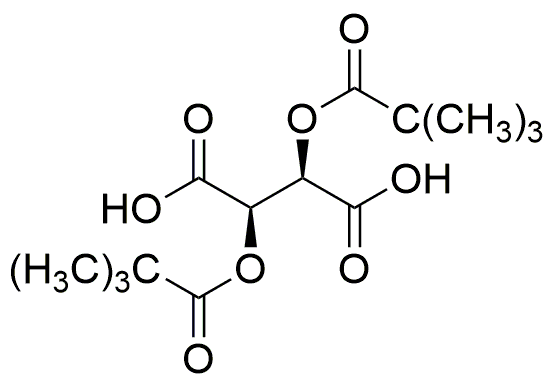(-)-Dipivaloyl-L-tartaric acid is widely utilized in research focused on various applications:
- Chiral Auxiliary in Synthesis: This compound is often used as a chiral auxiliary in asymmetric synthesis, helping chemists create specific enantiomers of pharmaceuticals more efficiently.
- Stabilizer in Pharmaceuticals: It serves as a stabilizing agent in drug formulations, enhancing the solubility and bioavailability of active pharmaceutical ingredients.
- Food Industry Applications: The compound is used in food chemistry as a flavoring agent and stabilizer, ensuring consistent taste and quality in food products.
- Polymer Chemistry: In polymer science, it acts as a modifier to improve the properties of polymers, such as flexibility and thermal stability, making it valuable in materials science.
- Research in Biochemistry: It is employed in biochemical research to study enzyme interactions and metabolic pathways, providing insights into biological processes.
General Information
Properties
Safety and Regulations
Applications
(-)-Dipivaloyl-L-tartaric acid is widely utilized in research focused on various applications:
- Chiral Auxiliary in Synthesis: This compound is often used as a chiral auxiliary in asymmetric synthesis, helping chemists create specific enantiomers of pharmaceuticals more efficiently.
- Stabilizer in Pharmaceuticals: It serves as a stabilizing agent in drug formulations, enhancing the solubility and bioavailability of active pharmaceutical ingredients.
- Food Industry Applications: The compound is used in food chemistry as a flavoring agent and stabilizer, ensuring consistent taste and quality in food products.
- Polymer Chemistry: In polymer science, it acts as a modifier to improve the properties of polymers, such as flexibility and thermal stability, making it valuable in materials science.
- Research in Biochemistry: It is employed in biochemical research to study enzyme interactions and metabolic pathways, providing insights into biological processes.
Documents
Safety Data Sheets (SDS)
The SDS provides comprehensive safety information on handling, storage, and disposal of the product.
Product Specification (PS)
The PS provides a comprehensive breakdown of the product’s properties, including chemical composition, physical state, purity, and storage requirements. It also details acceptable quality ranges and the product's intended applications.
Certificates of Analysis (COA)
Search for Certificates of Analysis (COA) by entering the products Lot Number. Lot and Batch Numbers can be found on a product’s label following the words ‘Lot’ or ‘Batch’.
*Catalog Number
*Lot Number
Certificates Of Origin (COO)
This COO confirms the country where the product was manufactured, and also details the materials and components used in it and whether it is derived from natural, synthetic, or other specific sources. This certificate may be required for customs, trade, and regulatory compliance.
*Catalog Number
*Lot Number
Safety Data Sheets (SDS)
The SDS provides comprehensive safety information on handling, storage, and disposal of the product.
DownloadProduct Specification (PS)
The PS provides a comprehensive breakdown of the product’s properties, including chemical composition, physical state, purity, and storage requirements. It also details acceptable quality ranges and the product's intended applications.
DownloadCertificates of Analysis (COA)
Search for Certificates of Analysis (COA) by entering the products Lot Number. Lot and Batch Numbers can be found on a product’s label following the words ‘Lot’ or ‘Batch’.
*Catalog Number
*Lot Number
Certificates Of Origin (COO)
This COO confirms the country where the product was manufactured, and also details the materials and components used in it and whether it is derived from natural, synthetic, or other specific sources. This certificate may be required for customs, trade, and regulatory compliance.


